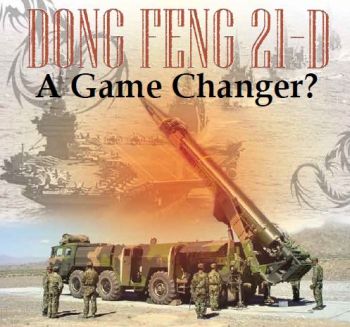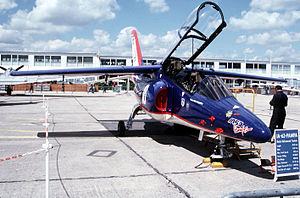The era of the mighty Battleships became history during the Second World War with the Japanese attack on Pearl Harbour. The US became the foremost protagonist of the Carrier Battle Group (CBG) as the prime instrument of power-projection. The 11 CBGs of the US Navy actually make that country a super power. In 1996, the dispatch of two US CBGs forced China to back down over Taiwan. This humiliation forced the Chinese to seek a novel and out of the box solution to the threat of US aircraft carriers. In the Dong Feng 21 D Anti-Ship missile it now seems to have found a very cost-effective answer. Though as yet untested in combat, the DF-21 Missiles have significantly enhanced the threat to the carriers. Any American decision to parade these carriers in any future confrontation over Taiwan would be seriously hamstrung by the fear of losing these carriers to a barrage of Dong-Feng 21 Ds fired in multiple salvos. The carriers could thus be sunk some 2–3,000 kms out at sea while their tactical on-board aircraft and cruise missiles would be well out of range of the Chinese mainland. The enhanced accuracy of these intermediate range Ballistic missiles has therefore posed a serious threat to the slow moving Aircraft Carrier armadas. How significant is this threat? Is it a game changer in the annals of naval warfare that will render this class of ships obsolete? Is the long era of the Aircraft Carrier finally over? The issue merits serious debate and analysis.
This article is published with the kind permission of “Defence and Security Alert (DSA) Magazine” New Delhi-India
 |
Battleships like the Hood, Repulse, Bismarck etc. had ruled the seas almost till the midpoint of the Second World War. These mighty battleships however were completely eclipsed by the advent of the Aircraft Carriers which have emerged since as the primary platform for power projection across the globe. The era of the Aircraft Carrier had dawned with the brilliantly successful Japanese attack on the mighty American Naval Base at Pearl Harbour. So eminently successful was the Japanese Fleet’s attack that Pearl Harbour has become a historical synonym for shock and surprise in war or any conflictual activity. Surprisingly it was the Armed Forces of the Totalitarian states like Germany and Japan that did out of the box thinking in the Second World War and came out with highly innovative solutions to counter the industrial and quantitative superiority of the Allied Powers. The Allied Powers were all, (with the exception of Soviet Russia), liberal democracies, who theoretically should have fostered more creative thinking and innovation. It was the Germans however, who synthesised the Stuka Dive Bombers with the fast moving Panzer Tank columns to generate shock and awe and effect deep and paralysing penetrations of the blitzkreig in land warfare. It was the Japanese who synthesised Tactical aviation with Sea Power to pioneer the advent of Aircraft Carriers. The Americans, till Pearl Harbour, had relied primarily upon the traditional gigantic Battleships to effect sea-control. By a curious coincidence, almost the entire American Battleship fleet was sunk at Pearl Harbour. The American Aircraft Carriers were not in harbour on that particular day and hence survived. It was natural therefore, that given the spectacular Japanese success with this class of ships, the American Carriers would lead the US Counter offensive across the Pacific. The Americans simply had no other option. The Americans began their relentless island hopping campaign across the Pacific chain of islands as they inched closer to the Japanese mainland. The turning point of the war came in the Battle of Midway, when the American and Japanese fleets of Aircraft Carriers fought a fierce engagement without the two fleets coming in sight of one another. US technological superiority turned the scales in this relentless battle of attrition via the Manoeuvre of the Carrier Battle Groups. The Aircraft Carrier Group has since then firmly established itself as the primary instrument of power projection.
Post the Second World War, the US enhanced its dependence on the Aircraft Carrier Battle Group as the primary tools of Power Projection. Today, the US Navy boasts of 11 Carrier Battle Groups. Today such a US Nuclear powered Aircraft Carrier Battle Group can traverse 5–700 nautical miles in a day and cover some 5,000 Nautical miles in a week. With its Fleet of F‑18 Hornet aircraft, it can reach out another 3–400 nautical miles and more and decisively mass effects at very long distances from the American mainland.
The Soviets were a traditional Continental power and the Soviet Navy therefore focused more on Sea-denial than Sea-control. This it did through a vast armada of nuclear and conventional submarines. However, towards the heyday of the Soviet Empire in the 1970s the Soviet Navy began to emulate its American counterpart and went in for a series of tactical to mid-sized Aircraft Carriers like the Gorshkov (now the Vikramaditya of the Indian Navy), the Veryag (now the Shelang of the Chinese PLA Navy) and the Kuznetsov. The Aircraft Carrier had proved its utility and efficacy as an ideal platform for Power Projection.
The DFs mark a significant paradigm shift that could make the strategy of sending giant aircraft carriers more dangerous because it could give China the option of firing warning shots if the US ships sail too close for Chinese comfort says Toshi Yoshiwara, Prof of Strategy and Policy at the US Naval War College
During the cold war the Aircraft Carrier played a lead role in the conflicts in Korea and Vietnam. After the collapse of the mighty Soviet Union, the US Carrier Battle Groups ranged virtually unchallenged over the global seas. They played a lead and decisive role in Gulf War I and Gulf War II as also Op Enduring Freedom in Afghanistan and also behind the scenes in Libya. Unchallenged Naval power and sea-lift capabilities alone enabled America to defeat Iraq and pulverise Afghanistan, Kosovo and Libya.
The Taiwan confrontation
In 1995, China had embarked on a rather aggressive military exercise to coerce and intimidate Taiwan. It fired a barrage of short ranged Tactical Ballistic missiles over Taiwan to overawe that state into calling off its Pro-independence agenda.
The Americans retaliated by dispatching two Nuclear Carrier Battle Groups to the Taiwan Straits. The Chinese were forced to back down. It was a significant humiliation and loss of face for the Chinese. They resolved to ensure that this would not happen ever again. The Chinese Navy determinedly set out to find an out of the box and innovative solution to the threat of the US Aircraft Carrier Battle Groups. The solution they have come up with is novel and quite cost-effective.

 von
von 

